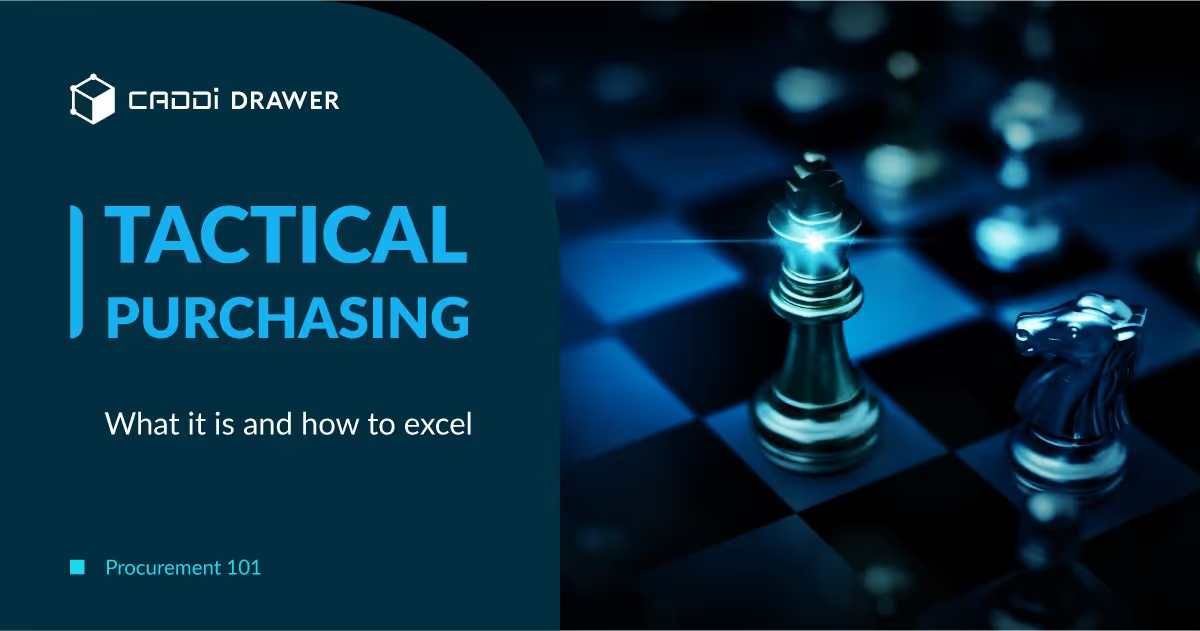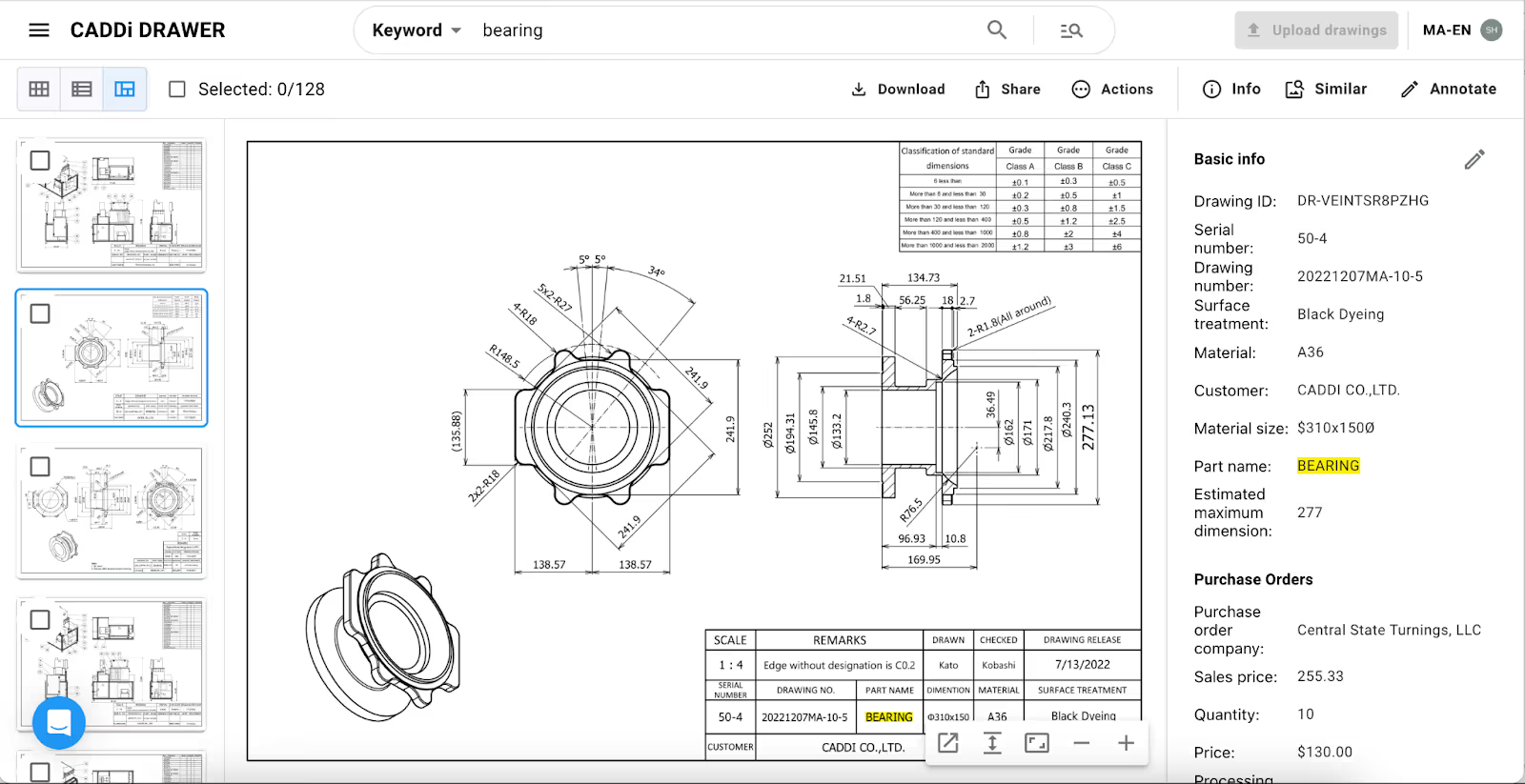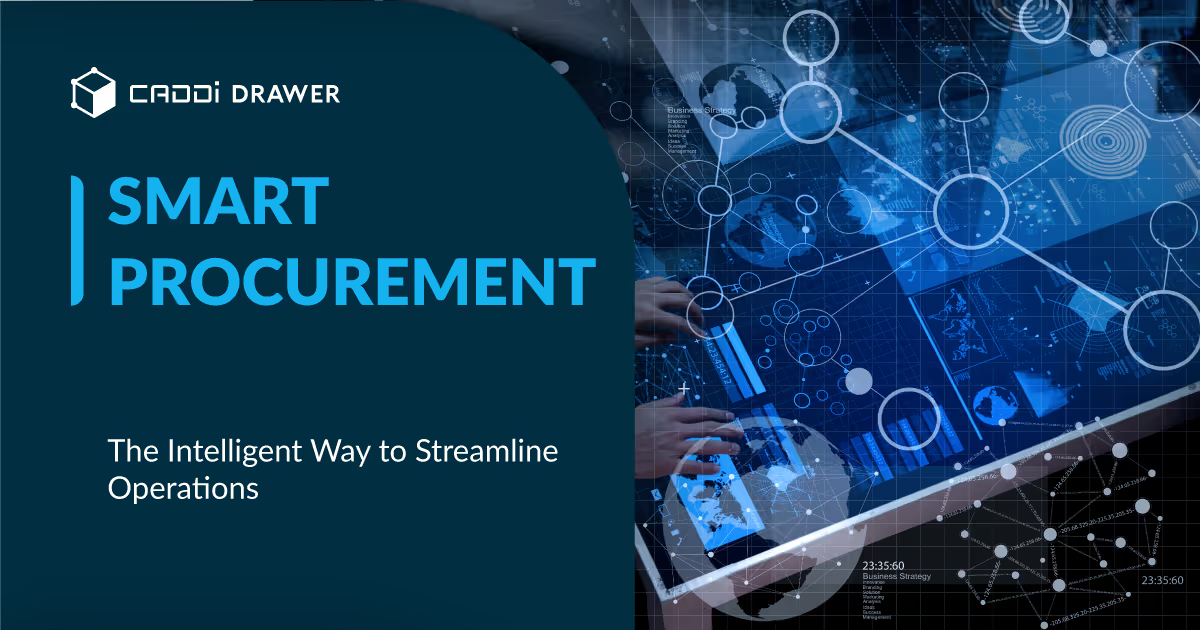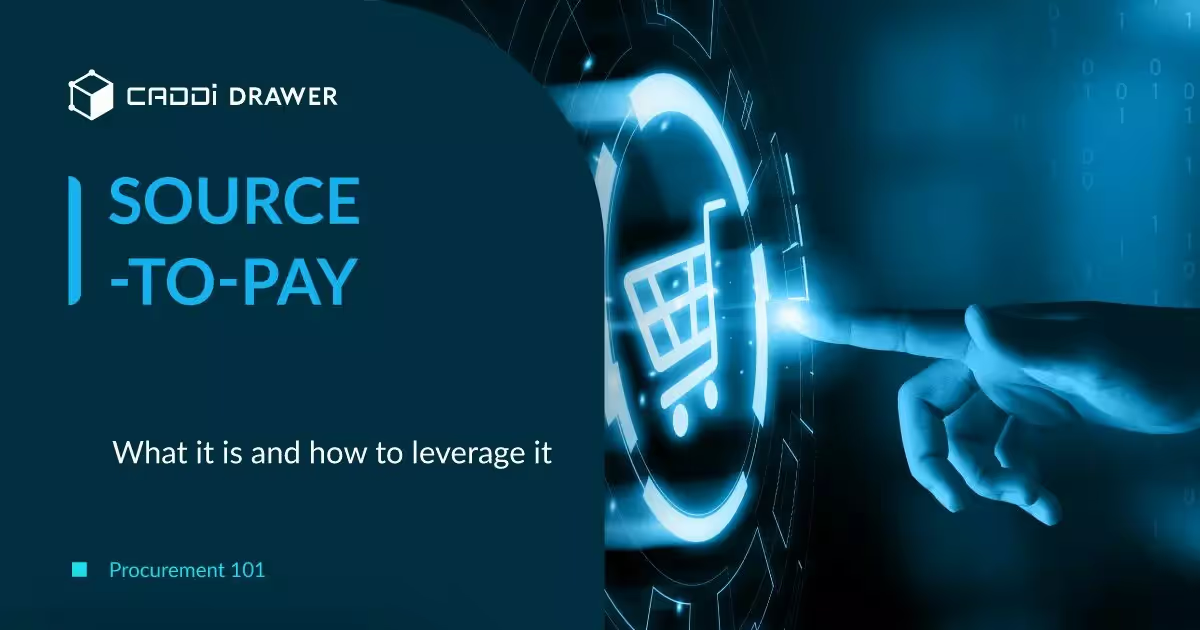Procurement 101: Tactical Purchasing – What it is and how to excel

Table of Contents

What is Tactical Purchasing?
Tactical purchasing is the day-to-day process of procuring the goods and services needed to keep a business running smoothly. It involves activities like:
- Identifying and selecting suppliers
- Negotiating prices and terms
- Placing purchase orders
- Expediting and tracking deliveries
- Handling returns and disputes
Think of tactical purchasing as the “nuts and bolts” that hold the supply chain together. Without it, production lines would grind to a halt, projects would be delayed, and the flow of materials would slow to a trickle.
Difference from Strategic Sourcing
In contrast to strategic sourcing, which takes a long-term view to optimize the supply base, tactical purchasing is all about meeting immediate needs in the most efficient way possible. It requires attention to detail, strong communication skills, and the ability to solve problems on the fly.
Some key outputs of the tactical purchasing process include:
- Purchase orders and contracts
- Goods receipts and invoices
- Supplier performance data
- Spend analysis reports
When tactical purchasing is firing on all cylinders, the result is a well-oiled supply chain that delivers the right goods to the right place at the right time – all while keeping costs under control. But when it falls short, the consequences can be severe: production delays, quality issues, budget overruns, and unhappy customers.
So while it may not be the most glamorous part of the business, tactical purchasing plays a crucial role in keeping the wheels turning. By understanding its key concepts and best practices, you can help ensure that your organization’s purchasing engine is running smoothly – and driving success.
Challenges in Implementing Tactical Purchasing
While tactical purchasing may sound simple in theory, putting it into practice can be a different story. Here are some of the key challenges that organizations face when trying to implement effective tactical purchasing:
1. Lack of Visibility
One of the biggest obstacles to smooth tactical purchasing is a lack of visibility into the supply chain. When buyers can’t see what’s happening upstream and downstream, it’s hard to make informed decisions about what to buy, when to buy it, and from whom. This can lead to:
- Stockouts and shortages
- Excess inventory and waste
- Missed opportunities for cost savings
2. Inefficient Processes
Another common challenge is inefficient purchasing processes that are bogged down by manual tasks, paper-based workflows, and a lack of automation. This can result in:
- Long lead times and delays
- Errors and inconsistencies
- High transaction costs
Without streamlined processes in place, tactical purchasing can quickly become a bottleneck that slows down the entire organization.
3. Poor Data Quality
Effective tactical purchasing relies on accurate, up-to-date data about suppliers, prices, lead times, and more. But in many organizations, this data is scattered across multiple systems and spreadsheets, making it difficult to get a clear picture of what’s going on. This can lead to:
- Bad sourcing decisions
- Overpaying for goods and services
- Difficulty measuring supplier performance
4. Skill Gaps
Tactical purchasing requires a unique blend of technical, interpersonal, and business skills. Buyers need to be able to:
- Analyze data and market trends
- Negotiate effectively with suppliers
- Manage relationships and resolve conflicts
However, many organizations struggle to find and retain talent with the right mix of skills, which can limit the effectiveness of their purchasing function.
5. Resistance to Change
Finally, one of the biggest barriers to implementing tactical purchasing best practices is often resistance to change within the organization. People may be set in their ways, skeptical of new processes and technologies, or simply too busy to take on new initiatives. Overcoming this resistance requires strong leadership, clear communication, and a willingness to invest in change management.
Solutions to Tactical Purchasing Challenges
Despite the challenges involved in tactical purchasing, there are proven solutions that can help organizations overcome these obstacles and achieve better results. Here are some of the most effective strategies:
1. Implement a Procure-to-Pay (P2P) System
One of the best ways to improve visibility and efficiency in tactical purchasing is to implement a procure-to-pay (P2P) system. A P2P system automates the entire purchasing process from requisition to payment, providing a single source of truth for all purchasing data. This can help:
- Reduce manual effort and errors
- Improve spend visibility and control
- Accelerate cycle times and reduce costs
2. Leverage Spend Analysis Tools
Another key solution is to leverage spend analysis tools to gain better insights into purchasing patterns and identify opportunities for savings. These tools can help organizations:
- Consolidate and cleanse purchasing data from multiple sources
- Identify maverick spend and off-contract purchases
- Negotiate better prices and terms with suppliers
3. Invest in Training and Development
To address skill gaps and ensure that buyers have the knowledge and expertise they need to succeed, organizations should invest in training and development programs. This can include:
- Basic procurement training for new hires
- Advanced negotiation and category management training for experienced buyers
- Soft skills training on communication, collaboration, and problem-solving
By upskilling their purchasing teams, organizations can improve the quality of their sourcing decisions and drive better business results.
4. Foster a Culture of Continuous Improvement
Finally, to overcome resistance to change and drive ongoing improvements in tactical purchasing, organizations need to foster a culture of continuous improvement. This means:
- Setting clear goals and metrics for purchasing performance
- Regularly reviewing and optimizing purchasing processes
- Encouraging experimentation and innovation
- Celebrating successes and learning from failures
By making continuous improvement a core part of their purchasing culture, organizations can stay ahead of the curve and adapt to changing market conditions and business needs.
Recent Trends and Future Outlook for Tactical Purchasing
In recent years, tactical purchasing has been transformed by a number of key trends, including:
- The rise of e-procurement and digital marketplaces, which have made it easier for buyers to find and compare suppliers online
- The growth of supplier collaboration and innovation, as companies look to their suppliers for new ideas and solutions
- The increasing importance of sustainability and social responsibility in purchasing decisions, as consumers and stakeholders demand more ethical and environmentally-friendly practices
For example, a survey by the Hackett Group found that 84% of procurement organizations have already implemented or are planning to implement e-procurement solutions, while 67% are focusing on supplier collaboration and innovation.
Looking ahead, the future of tactical purchasing is likely to be shaped by several key factors, including:
- The continued digitization of purchasing processes, as more companies adopt cloud-based solutions and AI-powered tools to automate and optimize their buying activities
- The growing importance of data management and analytics, as organizations seek to gain deeper insights into their spend patterns and supplier performance
- The need for greater agility and resilience in the face of disruption, as companies look to build more flexible and responsive supply chains
One area where we can expect to see significant innovation is in the use of unstructured data, such as supplier reviews, social media feeds, and news articles, to inform purchasing decisions. By leveraging natural language processing and machine learning techniques, companies will be able to gain a more comprehensive view of their suppliers and make more informed sourcing choices.
Overall, the future of tactical purchasing looks bright, as new technologies and best practices continue to emerge and evolve. By staying on top of these trends and investing in the right tools and talent, organizations can position themselves for success in the years ahead.
How CADDi Drawer Can Help Spend Analysis in Tactical Purchasing
We would like to mention CADDi Drawer here as a candidate for assisting with spend analysis and talent development in Tactical Purchasing. Using CADDi Drawer, the following analyses and data management tasks can be easily performed.
Similarity search of part drawings
The similarity search feature enables categorization not only by basic drawing information such as material but also by part shape. This is something that cannot be easily achieved with standard drawing management systems, ERP and PLM software.

Streamline activities in the procurement process
The following features enable you to streamline the time-consuming tasks of data collection and organization in procurement operations.
- Price data and supplier information can be automatically linked to each drawing and can also be exported together.
- By using keyword searches combined with similarity searches, the time spent searching for drawings and data in procurement tasks can be reduced.

In conclusion, tactical purchasing may not be the most glamorous function within the supply chain, but it is undoubtedly one of the most important. As the world becomes increasingly complex and unpredictable, the ability to manage tactical purchasing with agility, resilience, and innovation will be more critical than ever.
What is Tactical Purchasing?
Tactical purchasing is the day-to-day process of procuring the goods and services needed to keep a business running smoothly. It involves activities like:
- Identifying and selecting suppliers
- Negotiating prices and terms
- Placing purchase orders
- Expediting and tracking deliveries
- Handling returns and disputes
Think of tactical purchasing as the “nuts and bolts” that hold the supply chain together. Without it, production lines would grind to a halt, projects would be delayed, and the flow of materials would slow to a trickle.
Difference from Strategic Sourcing
In contrast to strategic sourcing, which takes a long-term view to optimize the supply base, tactical purchasing is all about meeting immediate needs in the most efficient way possible. It requires attention to detail, strong communication skills, and the ability to solve problems on the fly.
Some key outputs of the tactical purchasing process include:
- Purchase orders and contracts
- Goods receipts and invoices
- Supplier performance data
- Spend analysis reports
When tactical purchasing is firing on all cylinders, the result is a well-oiled supply chain that delivers the right goods to the right place at the right time – all while keeping costs under control. But when it falls short, the consequences can be severe: production delays, quality issues, budget overruns, and unhappy customers.
So while it may not be the most glamorous part of the business, tactical purchasing plays a crucial role in keeping the wheels turning. By understanding its key concepts and best practices, you can help ensure that your organization’s purchasing engine is running smoothly – and driving success.
Challenges in Implementing Tactical Purchasing
While tactical purchasing may sound simple in theory, putting it into practice can be a different story. Here are some of the key challenges that organizations face when trying to implement effective tactical purchasing:
1. Lack of Visibility
One of the biggest obstacles to smooth tactical purchasing is a lack of visibility into the supply chain. When buyers can’t see what’s happening upstream and downstream, it’s hard to make informed decisions about what to buy, when to buy it, and from whom. This can lead to:
- Stockouts and shortages
- Excess inventory and waste
- Missed opportunities for cost savings
2. Inefficient Processes
Another common challenge is inefficient purchasing processes that are bogged down by manual tasks, paper-based workflows, and a lack of automation. This can result in:
- Long lead times and delays
- Errors and inconsistencies
- High transaction costs
Without streamlined processes in place, tactical purchasing can quickly become a bottleneck that slows down the entire organization.
3. Poor Data Quality
Effective tactical purchasing relies on accurate, up-to-date data about suppliers, prices, lead times, and more. But in many organizations, this data is scattered across multiple systems and spreadsheets, making it difficult to get a clear picture of what’s going on. This can lead to:
- Bad sourcing decisions
- Overpaying for goods and services
- Difficulty measuring supplier performance
4. Skill Gaps
Tactical purchasing requires a unique blend of technical, interpersonal, and business skills. Buyers need to be able to:
- Analyze data and market trends
- Negotiate effectively with suppliers
- Manage relationships and resolve conflicts
However, many organizations struggle to find and retain talent with the right mix of skills, which can limit the effectiveness of their purchasing function.
5. Resistance to Change
Finally, one of the biggest barriers to implementing tactical purchasing best practices is often resistance to change within the organization. People may be set in their ways, skeptical of new processes and technologies, or simply too busy to take on new initiatives. Overcoming this resistance requires strong leadership, clear communication, and a willingness to invest in change management.
Solutions to Tactical Purchasing Challenges
Despite the challenges involved in tactical purchasing, there are proven solutions that can help organizations overcome these obstacles and achieve better results. Here are some of the most effective strategies:
1. Implement a Procure-to-Pay (P2P) System
One of the best ways to improve visibility and efficiency in tactical purchasing is to implement a procure-to-pay (P2P) system. A P2P system automates the entire purchasing process from requisition to payment, providing a single source of truth for all purchasing data. This can help:
- Reduce manual effort and errors
- Improve spend visibility and control
- Accelerate cycle times and reduce costs
2. Leverage Spend Analysis Tools
Another key solution is to leverage spend analysis tools to gain better insights into purchasing patterns and identify opportunities for savings. These tools can help organizations:
- Consolidate and cleanse purchasing data from multiple sources
- Identify maverick spend and off-contract purchases
- Negotiate better prices and terms with suppliers
3. Invest in Training and Development
To address skill gaps and ensure that buyers have the knowledge and expertise they need to succeed, organizations should invest in training and development programs. This can include:
- Basic procurement training for new hires
- Advanced negotiation and category management training for experienced buyers
- Soft skills training on communication, collaboration, and problem-solving
By upskilling their purchasing teams, organizations can improve the quality of their sourcing decisions and drive better business results.
4. Foster a Culture of Continuous Improvement
Finally, to overcome resistance to change and drive ongoing improvements in tactical purchasing, organizations need to foster a culture of continuous improvement. This means:
- Setting clear goals and metrics for purchasing performance
- Regularly reviewing and optimizing purchasing processes
- Encouraging experimentation and innovation
- Celebrating successes and learning from failures
By making continuous improvement a core part of their purchasing culture, organizations can stay ahead of the curve and adapt to changing market conditions and business needs.
Recent Trends and Future Outlook for Tactical Purchasing
In recent years, tactical purchasing has been transformed by a number of key trends, including:
- The rise of e-procurement and digital marketplaces, which have made it easier for buyers to find and compare suppliers online
- The growth of supplier collaboration and innovation, as companies look to their suppliers for new ideas and solutions
- The increasing importance of sustainability and social responsibility in purchasing decisions, as consumers and stakeholders demand more ethical and environmentally-friendly practices
For example, a survey by the Hackett Group found that 84% of procurement organizations have already implemented or are planning to implement e-procurement solutions, while 67% are focusing on supplier collaboration and innovation.
Looking ahead, the future of tactical purchasing is likely to be shaped by several key factors, including:
- The continued digitization of purchasing processes, as more companies adopt cloud-based solutions and AI-powered tools to automate and optimize their buying activities
- The growing importance of data management and analytics, as organizations seek to gain deeper insights into their spend patterns and supplier performance
- The need for greater agility and resilience in the face of disruption, as companies look to build more flexible and responsive supply chains
One area where we can expect to see significant innovation is in the use of unstructured data, such as supplier reviews, social media feeds, and news articles, to inform purchasing decisions. By leveraging natural language processing and machine learning techniques, companies will be able to gain a more comprehensive view of their suppliers and make more informed sourcing choices.
Overall, the future of tactical purchasing looks bright, as new technologies and best practices continue to emerge and evolve. By staying on top of these trends and investing in the right tools and talent, organizations can position themselves for success in the years ahead.
How CADDi Drawer Can Help Spend Analysis in Tactical Purchasing
We would like to mention CADDi Drawer here as a candidate for assisting with spend analysis and talent development in Tactical Purchasing. Using CADDi Drawer, the following analyses and data management tasks can be easily performed.
Similarity search of part drawings
The similarity search feature enables categorization not only by basic drawing information such as material but also by part shape. This is something that cannot be easily achieved with standard drawing management systems, ERP and PLM software.

Streamline activities in the procurement process
The following features enable you to streamline the time-consuming tasks of data collection and organization in procurement operations.
- Price data and supplier information can be automatically linked to each drawing and can also be exported together.
- By using keyword searches combined with similarity searches, the time spent searching for drawings and data in procurement tasks can be reduced.

In conclusion, tactical purchasing may not be the most glamorous function within the supply chain, but it is undoubtedly one of the most important. As the world becomes increasingly complex and unpredictable, the ability to manage tactical purchasing with agility, resilience, and innovation will be more critical than ever.
Ready to see CADDi Drawer in action? Get a personalized demo.
Subscribe to our Blog!
Related Resources












.svg)



.svg)
.svg)
.svg)


